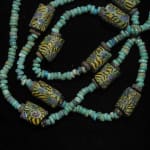Egyptian Faience Bead And Venetian Glass Necklace, 1600 BCE - 1100 BCE
Faience-Glass
FJ.4659
Necklace composed of genuine Egyptian New Kingdom faience beads and genuine Venetian glass trade beads. The love of ornament is as old as civilization itself, and a constant theme in...
Necklace composed of genuine Egyptian New Kingdom faience beads and genuine Venetian glass trade beads.
The love of ornament is as old as civilization itself, and a constant theme in human affairs, as this splendid necklace demonstrates. It brings together two kinds of beads from cultures separated by many centuries, yet makes them perfectly compatible and absolutely timeless in their beauty. Faience, a glass composite paste, was first created in Egypt more than four thou sand years ago. In the Egyptian new kingdom, artistry in faience was at its peak. Faience beads like these were worn by the citizens of Egypt for centuries. On the walls of tombs and temples, the aristocracy is depicted wearing faience necklaces. During the renaissance, Venetian craftsman rediscovered the ancient techniques for glassmaking. As Venetian trading power spread throughout the world, so did the demand for Venetian glass jewelry. In Africa especially, Venetian beads were used as barter for gold, ivory, spices and rare woods. In some places they acted as a kind of currency, and were used as a bridal dowry. It is easy to see why. Their subtle beauty, which blends perfectly with the rich colors of faience, still speaks to us today.
The love of ornament is as old as civilization itself, and a constant theme in human affairs, as this splendid necklace demonstrates. It brings together two kinds of beads from cultures separated by many centuries, yet makes them perfectly compatible and absolutely timeless in their beauty. Faience, a glass composite paste, was first created in Egypt more than four thou sand years ago. In the Egyptian new kingdom, artistry in faience was at its peak. Faience beads like these were worn by the citizens of Egypt for centuries. On the walls of tombs and temples, the aristocracy is depicted wearing faience necklaces. During the renaissance, Venetian craftsman rediscovered the ancient techniques for glassmaking. As Venetian trading power spread throughout the world, so did the demand for Venetian glass jewelry. In Africa especially, Venetian beads were used as barter for gold, ivory, spices and rare woods. In some places they acted as a kind of currency, and were used as a bridal dowry. It is easy to see why. Their subtle beauty, which blends perfectly with the rich colors of faience, still speaks to us today.



